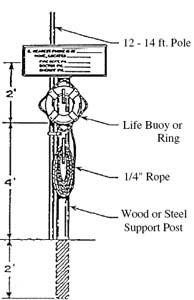Use the following format to cite this article:
Farm pond safety. (2012) Farm and Ranch eXtension in Safety and Health (FReSH) Community of Practice. Retrieved from http://www.extension.org/pages/63139/farm-pond-safety.
Although ponds on farms and ranches across the country serve a variety of functions, such ponds can also be a source of danger and liability. Victims of all ages, most typically small children, have drowned in farm ponds. Unsupervised children with little or no swimming instruction may play too close to the water’s edge and lose their balance. The dangers of ponds are not limited to children or those who cannot swim; other dangers are hidden in and beneath the water. Ponds may be contaminated by field runoff containing agricultural fertilizers, pesticides, livestock waste, and other pollutants that pose health concerns. Additional hazards in farm ponds include sharp rocks, animal bones, broken bottles, and other types of debris that can cause cuts and injuries.
As a pond owner, you should restrict pond use to invited guests only. In addition, take the following actions to minimize the dangers and liability associated with each pond on your farm or ranch:
- Post No Trespassing and/or Keep Out signs around the pond.
- Promote proper swimming instruction for all children.
- Eliminate physical hazards in and around the pond, which may include sloping entrance areas and pond edges.
- Dredge the pond regularly to remove submerged debris.
- Employ a certified laboratory to test the pond’s water quality each spring.
- Identify the depth of the water at various locations in the pond and indicate dangerous areas.
- Insert a stable yellow rescue post in close proximity to the pond’s edge. Outfit the rescue post with the attachments described below.
- Obtain a nylon rope that is as long as the width of the pond. Secure one end of the rope to a wooden block, and the other end to a buoy. (You can make a buoy by filling a gallon milk jug with approximately one pint of water.) Hang the rope and buoy on the rescue post.
- Mount a thin, lightweight 12- to 14-ft. pole (aluminum or PVC) on the rescue post. This pole can be used as a rescue pole for floundering victims.
- Secure a sign at the rescue post that displays pond rules and emergency contact information, including information for calling 911.

- Never allow anyone to swim alone. Individuals who supervise swimmers should be trained in water rescue procedures and CPR.
- If possible, install a fence with a locked gate around the pond.
Following the above safety recommendations can reduce your risk of an incident, but despite taking appropriate precautions, you may still face liability should a drowning or other incident occur in your pond. Contact your insurance agent to discuss liability insurance coverage related to your pond.
Use the following format to cite this article:
Farm pond safety. (2012) Farm and Ranch eXtension in Safety and Health (FReSH) Community of Practice. Retrieved from http://www.extension.org/pages/63139/farm-pond-safety.
Sources
Bean, T. (2008) Farm pond safety. Ohio State University Extension. No longer available online.
Murphy, D. and Fetzer, L. (12014) Farm pond safety. The Pennsylvania State University College of Agricultural Sciences. Retrieved from https://extension.psu.edu/farm-pond-safety.
Training module: Farm pond safety. (2003) The Ohio State University Agricultural Tailgate Safety Training. Retrieved from http://nasdonline.org/1755/d001730/farm-pond-safety.html.
Willcutt, H. (2002) Farm pond safety. Mississippi State University Extension Service. Retrieved from https://extension.msstate.edu/sites/default/files/publications/publicati….
